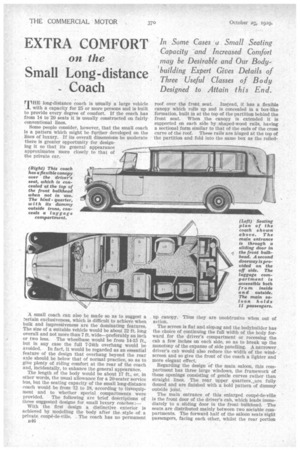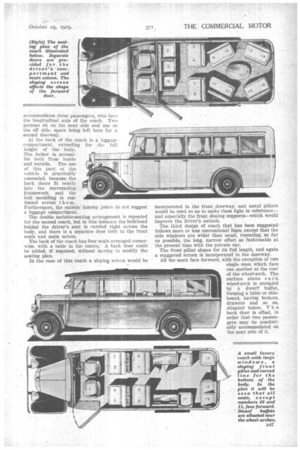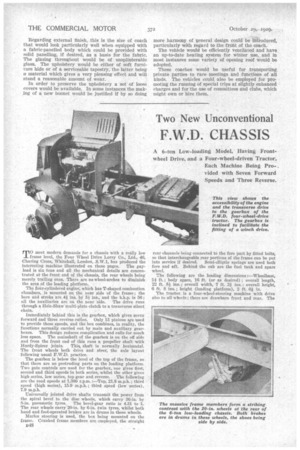EXTRA COMFORT
Page 112

Page 113

Page 114

If you've noticed an error in this article please click here to report it so we can fix it.
on the
Small Long-distance Coach
In Some Cases a Small Seating Capacity and Increased Comfort may be Desirable and Our Body'building Expert Gives Details of Three Useful Classes of Body Designed to Attain this End.
THE long-distance coach is usually a large vehicle with a capacity for 25 or more persons and is built to provide every degree of comfort. If the coach has from 14 to 20 seats it is usually constructed on fairly conventional lines.
Some people consider, however, that the small coach is a pattern which might be ftrther developed on the lines of luxury. If its overall dimensions be moderate there is greater opportunity for designing it so that its general appearance approximates more closely to that of the private car.
A small coach can also be made so as to suggest a ?ertain exclusiveness, which is difficult to achieve when bulk and impressiveness are the dominating features. The size of a suitable vehicle would be about 22 ft. long overall and not more than 7 ft. wide—preferably an inch or two less. The wheelbase would be from 14-15 ft., but in any case the full 7-24th overhang would be avoided. In fact, it would be regarded as an essential feature of the design that overhang beyond the rear axle should be below that of normal practice, so as to give plenty of riding comfort at the rear of the coach and, incidentally, to enhance the general appearance.
The length of the body would be about 17 ft„ or, in other words, the usual allowance for a 20-seater service bus, but the seating capacity of the small long-distance coach would be from 12 to 18, according to its4equipmeat and to whether special compartments were
provided. The following are brief descriptions of three suggested designs for small luxury coaches:—
With the first design a distinctive exterior is achieved by modelling the body after the style of a private coupe-de-ville. The coach has no permanent D46 roof over the front seat. Instead, it has a flexible canopy which rolls up and is concealed in a box-like formation, built in at the top of the partition behind the front seat. When the canopy is extended it is supported on each side by shaped-wood rails, having a sectional form similar to that of the ends of the cross curve of the roof. These rails are hinged at the top of the partition and fold into the same box as the rolled up canopy. Thus they are unobtrusive when out of action.
The screen is flat and sloping and the bodybuilder has the choice of continuing the full width of the body forward for the driver's compartment or recessing the cab a few inches on each side, so as to break up the monotony of the expanse of side panelling. A narrower driver's cab would also reduce the width of the wind. screen and so give the front of the coach a lighter and more elegant effect. ,
Regarding the design of the main saloon, this compartment has three large windows, the framework of these openingS consisting of gentle curves rather than straight lines. The rear upper quarters.,;are fully domed and are finished with a bold pattern of dummy'
outside joint. .
The main entrance of this enlarged coup4-de-ville is the front door of the driver's cab, which leads immediately to a sliding door in the front bulkhead. The seats are distributed mainly between two sociable compartments. The forward half of the saloon seats eight Passengers, facing each other, whilst the rear portion accommodates three passengers, who face the longitudinal axis of the coach. Two
persons sit on the near side and one on the off side, space being left here for a second doorway.
At the back of the coach is a luggage compartment, extending height of the hotly. The locker is accessi ble both from inside
and outside. The use of this part. of the
vehicle is practically concealed, because the back doors fit neatly
into the :surrounding . framework, and the
belt moulding is continned across t h e in. Furthermore, the outside dummy joints do not suggest a luggage compartment.
The double sociable-seating arrangement is repeated, for the second coach, but in this instance the bulkhead behind the driver's seat is carried right across the body, and there is a separate door both to the front seats and main saloon.
The back of the coach has four seats arranged cornerwise, with a table in the Centre. A back door could be added, if required, without having to modify the seating plan.
In the ease of this coach a sloping screen would be incorporated in the front, doorway, and metal pillars would be used so as to make them light in substance— and especially the front sloping supports—which would improve the driver's outlook.
The third design of coach that has been suggestedfollows more or less conventional lines, except that the side windows are wider than usual, repeating, so far as possible, the long, narrow effect so fashionable at the present time with the private car.
The front pillar slopes for its full length, and again a staggered screen is incorporated in the doorway.
All the seats face forward, with the exception of two single ones, which face one another at the rear of the wheel-arch. The surface above each wheel-arch is occupied by a dwarf buffet, forming a table or sideboard, having lockers, drawers and so on, situated below. T h e back door is offset, in order that two passengers may be comfortably accommodated on the near side of it. Regarding external finish, this is the size of coach that would look particularly well when equipped with a fabric-panelled body which could be provided with solid panelling, if desired, as a basis for the fabric. The glazing throughout would be of unsplinterable glass. The upholstery would be either of soft furniture hide or of a serviceable tapestry, the latter being a material which gives a very pleasing effect and will stand a reasonable amount of wear.
In order to preserve the upholstery a set of loose covers would. be available. In some instances the mak..ing of a new bonnet would be justified if by so doing
more harmony of general design could be introduced, particularly with regard to the front of the coach.
The vehicle would be efficiently ventilated and have an up-to-date heating system for winter use, and in most instances some variety of opening roof would be adopted.
These coaches would be useful for transporting private parties to race meetings and functions of all kinds. The vehicles could also be employed for promoting the running of special trips at slightly enhanced charges and for the use of committees and clubs, which might own or hire them.




























































































































































































